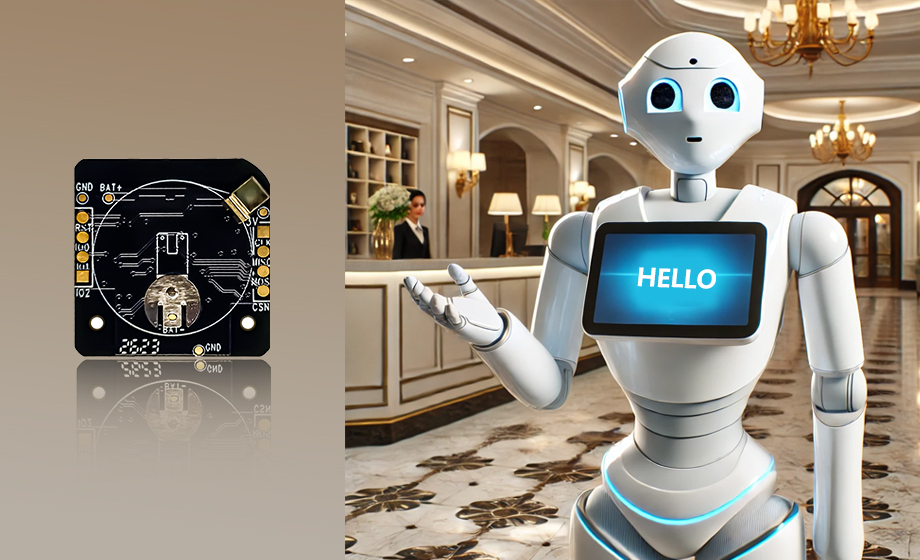I. Introduction
With the rapid development of science and technology, wireless communication technology has been widely used in various fields, especially in robotics, and the role of wireless ranging module has become increasingly prominent. Ultra-Wideband (UWB) wireless ranging module, as a new wireless communication technology, has shown great potential in robot positioning, navigation and obstacle avoidance due to its high precision, high anti-interference and low power consumption. This paper will discuss the application and development of UWB wireless ranging module in robot field.

Second, ultra Wideband (UWB) wireless ranging module overview
Principles of UWB technology
Ultra-wideband (UWB) technology is a carrier-less communication technology that transmits data using narrow pulses of non-sine waves from nanoseconds to microseconds. These pulses have extremely short durations and a wide spectrum, making it possible to achieve high precision ranging in complex environments. The UWB wireless ranging module calculates the distance between two points by measuring the transmission Time (Time of Flight (TOF) or Time Difference of Arrival (TDOA) of the pulse signal from the transmitting end to the receiving end.
UWB technology features
(1) High precision: UWB technology has centimeter-level or even millimeter-level ranging accuracy, which can meet the needs of high-precision positioning of robots.
(2) High anti-interference: Because the UWB signal adopts broadband transmission, it has good anti-interference performance and can work stably in complex environments.
(3) Low power consumption: the pulse width of the UWB signal is very short, which makes the UWB device have low power consumption when sending data, which is suitable for low-power robot systems.
Third, the application of UWB wireless ranging module in the field of robotics
Robot positioning and navigation
In robot systems, accurate positioning is the key to autonomous navigation. The UWB wireless ranging module can realize the accurate positioning of the robot by measuring the distance between the robot and multiple fixed points in the surrounding environment. At the same time, combined with other sensor data (such as inertial measurement units, liDAR, etc.), autonomous navigation and path planning of the robot can be realized.
Robot obstacle avoidance and safety protection
The UWB wireless ranging module can be used to monitor the distance of obstacles in the environment around the robot in real time and provide obstacle avoidance function for the robot. By setting an appropriate safe distance threshold, when the robot approaches an obstacle, it can automatically adjust its movement trajectory or slow down to avoid collision. In addition, UWB technology can also be used for robot safety protection, by measuring the distance between the robot and the human body or other sensitive objects, to achieve the safe shutdown and alarm function of the robot.
Robot cooperative operation
In the scenario of multiple robots working together, UWB wireless ranging module can realize the relative positioning and distance measurement between robots. By acquiring the relative position and distance information between the robots in real time, the functions of cooperative formation and cooperative handling between the robots can be realized, and the working efficiency and safety can be improved.
Fourth, the development trend of UWB wireless ranging module in the field of robots
Improved accuracy and stability
With the continuous development of UWB technology, the accuracy and stability of UWB wireless ranging module will be further improved in the future. By means of optimization algorithm and improvement of hardware design, higher precision ranging and more stable performance can be achieved to meet the demand for high-precision positioning in the robot field.
Integration and intelligence
With the continuous development of the Internet of Things and artificial intelligence technology, the future UWB wireless ranging module will pay more attention to integration and intelligence. By fusing UWB technology with other sensor technologies such as inertial measurement units, liDAR, etc., more comprehensive environmental awareness and smarter decision-making capabilities can be achieved. At the same time, by introducing artificial intelligence technology such as machine learning, the autonomous learning and optimization function of UWB wireless ranging module can be realized, and its adaptability in complex environment can be improved.
Low power consumption and long battery life
In robot systems, low power consumption and long battery life are one of the key performance indicators. In the future, UWB wireless ranging module will pay more attention to low-power design, and achieve lower power performance by optimizing circuit structure and reducing the use of power consumption devices. At the same time, by introducing technical means such as energy recovery and energy-saving management, the endurance capacity of UWB wireless ranging module can be further improved to meet the needs of long-term work of robots.
V. Conclusion
Ultra-wideband (UWB) wireless ranging module, as a new wireless communication technology, has shown great application potential in the field of robotics. With high precision positioning, high anti-interference and low power consumption, the UWB wireless ranging module provides the robot with reliable positioning, navigation and obstacle avoidance functions. In the future, with the continuous development of technology, UWB wireless ranging module will make greater breakthroughs in accuracy, stability, integration and intelligence, injecting new impetus into the development of the robot field.



